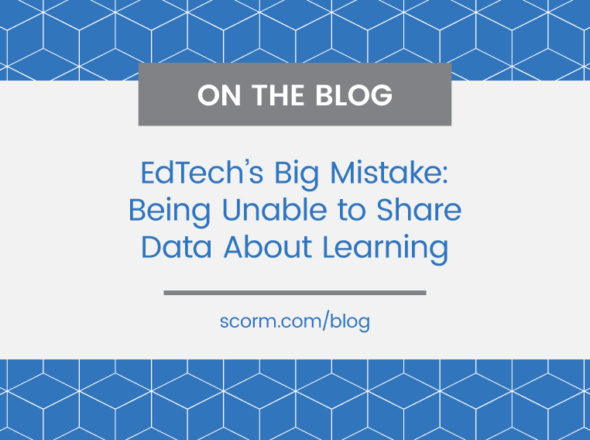Key Points:
- Need for offline / low bandwidth support
- Send out zip files of content, would like to know when people use it
- Would like to create a flash piece with SCORM call in it to track
- Would like to know why learners stopped taking a course
- Dual tracking / usage statistics — content is freely provided and may run in another LMS, but would like to know when it’s used
- Use several LMS systems internally, could use a better way to synchronize tracking
- E-learning content will need to be deliverers anywhere on any device
- Learners should have a greater ability to connect and create supplemental materials
First of all, can I ask you what your role is with the Nature Conservancy and how does it relate to e-learning?
I am a learning manager working on our technology learning center, and specifically within that role I manage the three LMSs that we currently use to get our e-learning out, both internally and externally. I also do a little bit of the development and stuff like that, but mainly I work with LMS systems.
So, with those LMS, with that content you present on those LMSs, the training you’re doing, what new and/or innovative stuff are you doing to train folks or to present learning?
New and innovative? I’m not sure if it’s new, but our specific concern and where we have the most problems is since we are focused on conservation issues globally, we work with a lot of partners from around the world. And just for example, on our external learning portals, we have people coming in from over 150 different countries. And while that’s fine and dandy for people who have bandwidth, we are trying to reach the conservation practitioners, and professionals, and managers, in smaller, less developed areas, where bandwidth is a huge issue. And so we have to build our courses as small as possible, but still create a very interactive, engaging piece. Which is a unique challenge because the folks we’re trying to get to don’t always have the bandwidth connectivity to get to it or to stay online for long periods of time.
Okay, so is it the case that it’s not just the size of the course, but the fact that they need a continuous connection, or would you be able to, in a way, make the courses somewhat larger and have that acceptable if the protocols were set up more so you could download some content ahead of time, have them interact with that content, and then later sync back up?
In an ideal world, that’s what we would like: either there’s pieces they can download to their computer, and then when they’re finished it sends something back seamlessly, or they link back into the system, and upload it back. The way we get around that most of the time is for people that are having those problems is we try to make some of the SCORM material packaged up as a zip file that can run locally on their computer, and then ask them that when they’ve completed it, just take a screen shot of that last page that says they’ve successfully completed it, and then we have to manually update it. Which isn’t a huge issue other than we’re trusting them to actually get to the end of it, and sometimes we never hear back from them, and once they download that content we have no idea where it actually goes. So we lose control over it, in that form. Not the authoring files.
Right, that then people can just pass it around, you don’t even know if they’ve taken it. Interesting. So there’s one other thing, that I’ve heard requested that seems like it could help with this scenario too. For the one facet, but not the other, which is that some people requesting for content to be able to run on its own without launching from the LMS, but then when you’re done or really at any time the content is designed to do it,start-up communication with the LMS and say, oh by the way, here’s this learner that you didn’t know about, track their progress.
Yeah, that would definitely work as well. We’d like to be able to track our learners, so given those scenarios, it could potentially work. One of the other areas where we are looking at and trying to see a way to do this and I don’t know if there is or not, and it’s some of our developers who are digging into it a little bit more than me, is rather than always having to create a SCORM-based activity in the LMS, wondering if we’d be able to embed a Flash piece that has a SCORM call in it, launch it just like any other web page and send that information into the LMS. That sounds like something along the lines you’re talking about.
Yeah, it’s a similar thing to say that you don’t really have to launch it as a SCORM course, just that at some point the content or whatever granularity can say at some point, okay I’d like to track back, some SCORM tracking data and treat me like a SCORM course.
Yes, that would be great.
So what is it that you tend to want to track about your learners, and not just what you actually are tracking, but what would be nice to track that you haven’t been able to?
In that sense I don’t think we’re missing anything. What we’re more interested in is who is taking it and how far along they progressed in it and if they’ve completed it. The only other information we’d want to track, and I don’t think this is something that SCORM can help us with is more of the motivational: why did they stop taking it? But we’re just, as an organization, we’re not really interested — well, I shouldn’t say we’re not interested, but we just don’t, we’re more interested in getting it out there and seeing it being used. And so tracking by person, organization, and progress is really all we need. We don’t do a lot scoring and things like that to where we’re worried about how well they did. Or the amount of time it took them or didn’t take them, those types of things just don’t matter to us as an organization.
So, I guess that’s — it’s similar to content just being able to track back without necessarily having been lost to an LMS, but it also sounds like you might kind of be interested in, even in if your content gets put into someone else’s LMS at some point, or is passed around without an LMS, if there was some standard way for it to track back to you, and maybe even ask the user to let them know I was going to do that and ask for a little bit more information, to give you some sort of statistics, you might be interested in something like that.
Yeah, and I think that would definitely be something of interest, because one of the things we are going to look at now and over the next year or two is creating a conservation learning portal to where we have a set structure of courses people can take. But we’re also looking at partnering with other organizations and how we can all that content together, but still track it successfully on an organizational basis. And we have a youth program that’s looking to design curriculum and then share it out to thirty or forty schools across the US. So if there was a way to centrally track who is using it, across that type of sense no matter what system they might be using it in, that would be ideal.
You mentioned you had three LMSs, do you have any integration between them or with other systems, or do you see the need for integration with other systems, particularly integration around the tracking data or courses that people are taking themselves?
We didn’t start out to have three LMSs. And we’re trying to whittle that down. Currently we use PeopleSoft Enterprise Learning Manager, and IntroLearn LSP, and then Moodle 1.9. And the PeopleSoft and IntroLearn systems do do a file transfer a couple of times a day, because we had some courses that were donated to us and we have to use them on that IntroLearn system. So really there’s just a shell pointing people to them in PeopleSoft, but then we have to sync up the user data for whose enrolling and their progress. So that’s just sort of a data file transfer. Which doesn’t always work really well, but we’re trying to figure out how to get around that.
Then, our Moodle system is more for our external folks and partners, and right now that’s not synced with anything but we would like to have it synced with our internal HR MS, with the PeopleSoft system. That’s why we have PeopleSoft, because HR bought the PeopleSoft HR MS system, and it included the LMS component with it. But we liked the features that Moodle has in terms of being able to do some more collaboration and cooperative learning. Right now, if we run a course there we just sort of throw a link up on our intranet and then point people to it for internal staff. There’s no way we can track it, so we would like to fix that moving forward.
So it’s not even tracked in Moodle, or —
It’s tracked, our course registration, their enrollment, and their activity is tracked in the
Moodle system, but at no point does it get tied back in to any internal learning plans on our internal, the PeopleSoft LMS, or part of their employee record. It’s just sort of lost. We push them out there to take it, to take advantage of some of the features of it, but there’s no — they don’t get credit for it as an employee, because it doesn’t ever show up on their official HR file, which is that PeopleSoft system.
So, would it be fair to say that what you really would want to integrate across systems is basically completions, the learner, the course they took, the fact they completed it?
Yeah, that’s really what we would need. The name, probably a date, when they enrolled and when they completed it, and the fact that they did.
B: What do you think will change about e-learning in the next five or ten years and what do you think should change?
What do I think will change and what should change? I think given the way we see the whole basis of social learning connectivity, and sort of cloud-based platforms, I think you’re going to see e-learning content need to be delivered anywhere on any device. Sort of along the lines of the whole mobile learning, so no matter where you are or how you connect to the net, or an internal network, you can still get that same content, however it was designed to be delivered and still should be able to, regardless of device or access, should still track into that system. But then, I think with that what you’ll start seeing change, or what I would hope to see change, is greater ability for learners to connect and come together. Not necessarily to change that content, like a wiki change, because there was probably a reason it was put together in that format, but to create more supplemental materials and things of that nature to help support that larger learning community. I would hope that’s what would change, myself.
In terms of what needs to change, I don’t think anything needs to change. It does work as it was, somewhat, originally intended. So it’s doing its job, I think it’s a natural for it to change as needs and the industry do change. So I guess the only need for it to change is to keep up with the current needs of the market, but not necessarily because it isn’t doing anything or that its functionality was flawed as is.
Do you do any instructor or classroom-led training and do you have any needs to blend the two together?
D: We do to an extent, typically when we do face-to-face training, they are purely instructor led, for whatever reason. My team doesn’t work on that, but our HR learning team does. Within my team, typically we don’t do a lot of it, but we do do some blended learning. But it’s not face-to-face classroom based, but web-conferencing based? You’ll go into a webinar with an instructor for a couple hours, and then we’ll have other activities you’ll be responsible for at other times, whether it’s going through a SCORM packaged e-learning piece, or doing some sort of practice session in a training environment for one of the systems we’re running, or something like that.
And would you say you have any communication integration, synchronization needs that aren’t being met in that area currently?
No, not really. Again, just looking with the instructor-led stuff, that we’re capturing that, it’s the instructor’s responsibility to mark attendance so that’s working with the SCORM pieces again, more knowing who is accessing it and if they completed it or not. And the integration with a live-system testing environment, we’re putting them in that environment so they get practice in the system and we’re leaving that up to the instructor to work with them and make sure the activities are getting concluded. I would say our needs, as basic as they are in that type of scenario, are being met.
Our biggest needs are being able to get our content out to people, regardless of where they are, and being able to track their activity with it based on how they access it. I think we covered it.


